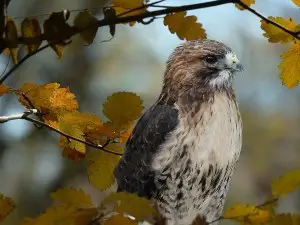
If you’re a sparrow hawk lover you may be concerned about their nesting habits because or urbanization. So where do sparrow hawks nest?
Sparrow hawks in the wild nest in dense woodland areas that are very airy. They can have multiple nests sites and these need to be in close proximity to their food sources, they also need to be in secluded areas. In urban areas, they build nests on billboard signs and tall towers.
One of the most spectacular birds of prey is the sparrow hawk. This article will be a look into their world to see how and just where do sparrow hawks’ nest. Bird watchers, lovers, wildlife activists and nature enthusiasts will benefit from this article as we take a closer look at this hawk specie.
This hawk is a member of the Accipitridae family of birds. Sparrow hawks are opportunistic, carnivorous birds of prey. They feed on smaller birds such as sparrows, thrushes, starlings, and pigeons as well as small mammals and insects.
Table of Contents
Where do sparrow hawks nest?
As a result of urbanization, displaced birds such as sparrow hawks have had to adapt and find new nesting sites. In urban areas, sparrow hawks set up nests on billboard signs, tall towers, and just below the canopies of tall trees.
To fuel their high metabolism, they have to keep close to their prey. In recent times home gardens have been visited by sparrow hawks. These hawks prey on songbirds and other birds that visit home gardens.
In the wild and in less urbanized areas, sparrow hawks setup nests in dense woodlands close to airy spaces. Sparrow hawks prefer nesting in the lower parts of tall tree canopies, closer to the trunk in areas away from view. These animals prefer seclusion and are territorial.
Nests are very important, they are the homes and cradles for their young. The safety, wellbeing and survival of young hawks rely on the nest’s sturdiness, ability to deter poachers and comfort. These birds have evolved over centuries to keep their nets clean and maintained.
How do they build their nest?
They say beauty is the eyes of the beholder, this is true as hawk nests can look like a random mess of twigs and foliage. Well, to us they are, in fact, the nests are carefully constructed over several days even weeks.
Nests get built with what’s closest to the nesting spot. Twigs, pine needles, strips of tree bark, foliage and even grass are strung together to form a comfy interior with a prickly exterior. They are built this way for comfort and to ward off poachers and unwanted visitors.
Even though they do not have distinct natural predators that prey on them, hawks prefer secluded, concealed areas for nesting. Sparrow hawks will seek out secluded and concealed niches in trees and buildings to setup nests. These places are preferred as they are good places to safeguard their young.
How far do hawks travel from their nests?
Sparrow hawks are territorial and have several nests. Nets are located various distances apart from 0.3 to 1.3 miles apart. The number and distances between nests are dependent on the availability of nest spots as much as food supply.
More food supply leads to more nesting spots and smaller territories, these are easier to hunt and defend. Less food supply leads to less available nesting spots resulting in wider nesting sites.
Sparrow lounge without much movement. Their eyes scope the terrain for prey. These birds rely on the element of surprise to nab an unsuspecting meal. Staying still and keeping in one place makes them almost invisible and much as their feathers do. Thus they prefer to build nests closer to their prey
Do hawks return to the same nest each year?
Nest building can take a very long time, the process can last between 4 days to even weeks. The birds will make several nests spread out across their territory and flight path. This ensures that they have places to nest when in need.
Because of the effort put in it is understandable that they tend to re-use nests they’ve made before. Often, the birds will spruce up an existing nest if another gets removed, damaged or is no longer accessible. So yes, they do return to the same nests each year. That being said, they will create new ones if need be.
What is the life span of hawks?
Hawks are opportunistic omnivores that have existed for centuries and many evolutions. The average life span of a hawk is 12 to 20 years in the wild and approximately 30 years in captivity.
This gap exists because of the differences in food and accommodation. As wildlife sanctuaries and preserves become fewer, urbanization thrives, available nesting spots and food for hawks’ decrease. Also, pesticides also negatively impact their longevity.
Conclusion
Sparrow hawks are iconic birds of the Accipitridae family of opportunistic carnivorous birds of prey. They nest in high secluded areas such as tall trees and towering buildings which are relatively close to prey or feeding grounds. These birds spend a lot of time and effort in making their nests as it is vital to the safety and comfort of their young. They also revisit and repair existing nests.
If you’re reading this article you may also enjoy these other articles on hawks. Click the link to read the article. What are hawks afraid of, when do hawks lay eggs, where do sparrow hawks live, what do baby hawks eat and where do hawks nest.

